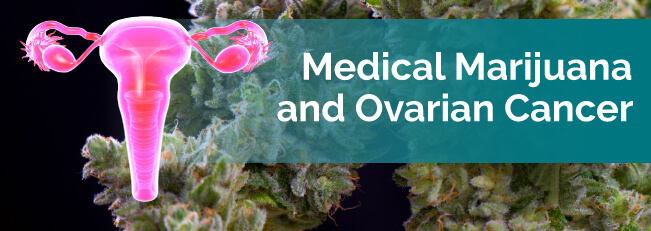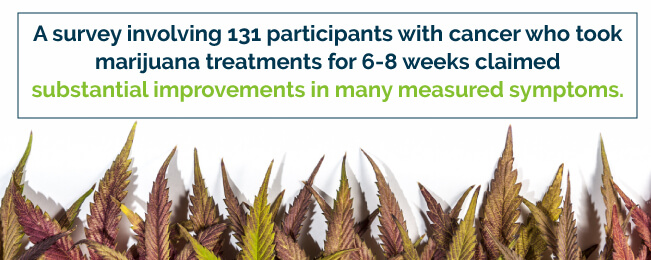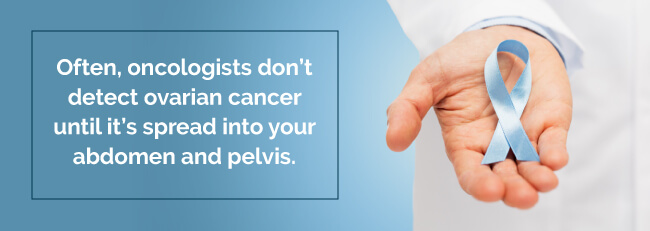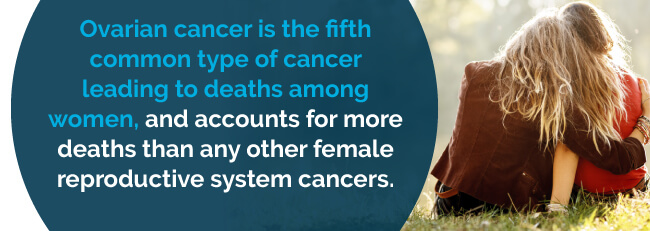
If you’ve received a diagnosis of ovarian cancer, knowing what to expect could help you cope better. Below is a guide to ovarian cancer and the different types, symptoms, risk factors and treatments, including medical marijuana for ovarian cancer.
A woman’s reproductive system contains two ovaries which are vital in the role of reproduction. The ovaries are attached to either side of the uterus and are responsible for producing sex hormones including estrogen and progesterone as well as releasing eggs. Sometimes the orderly process of cell growth, death and replacement becomes compromised. Cells begin to grow out of control and without order, when this happens, a tumor can develop on or inside the ovaries. The tumor can be benign or malignant. Malignant tumors are cancer. The two most common types of ovarian cancer are germ cell carcinoma and epithelial carcinoma. Germ cell cancer begins in the egg cells located within the ovaries. Ovarian epithelial cancer develops from cells that make up the surface of the ovary. Symptoms of ovarian cancer include fatigue, pressure or pain in the abdomen, pelvis, back or legs, a bloated or full feeling in the abdomen or pelvis, nausea, indigestion, gas, constipation or diarrhea. Ovarian tumors are at risk for spreading to other organs, a process called metastasis. Ovarian cancer can metastasize in three ways. Invasion: The tumor grows large enough to invade nearby organs. Shedding: Individual cancer cells break off from the main ovarian tumor and transplant to nearby organs. Spread: Cancer cells travel through the lymphatic system to lymph nodes and other organs in the pelvis, abdomen and chest. The diagnosis of ovarian cancer is made by physical and pelvic exams, transvaginal ultrasounds, CA-125 blood test and biopsy. Cancer of the ovaries is the leading cause of reproductive cancer death in women as it is often diagnosed at an advanced stage. Ovarian cancer treatment most often includes surgery to remove the ovaries and any other organs that may be affected. Chemotherapy and radiation may also be used to treat other symptoms or complications of the disease. Prognosis depends on the stage at which the cancer is diagnosed. Learn more below about how medical marijuana can help treat ovarian cancer.
When it comes to cannabis and ovarian cancer, there are a variety of ways patients incorporate medical weed treatment into their therapy regimens. Some patients use cannabis to help them with their symptoms of pain, nausea and vomiting, while others use it to lift their moods and alleviate their anxiety and depression. Either way, the herb helps improve their quality of life.
Find A Doctor Find A Dispensary

A survey involving 131 participants with cancer who took marijuana treatments for six to eight weeks claimed substantial improvements in many measured symptoms like:
Medical pot has also been shown to reduce neuropathic pain significantly, even pain regular cancer treatments were unsuccessful at managing. And it didn’t affect the success of chemo adversely.
Cachexia, a metabolic disorder that causes extreme appetite and weight loss, is often a side effect of chemotherapy. Marijuana can significantly stimulate patients’ appetite, according to research. Patients who used medical weed reported their food tasted better and they had a bigger appetite.
Last, research additionally suggests weed helps reduce hand and foot swelling that could occur with chemo. Both CBD and THC were found to have anti-inflammatory properties.
While research on medical weed is consistently growing, there’s much more scientists and researchers need to discover about its treatment capabilities with cancer. If you’re considering using medical cannabis for ovarian cancer to ease your chemo-related symptoms, be aware there are several options for taking marijuana.
Because smoke inhalation is so damaging to your lungs, smoking is the least helpful way to use pot. More effective methods for medical pot treatment include, but are not limited to:
Some patients use juicing with raw cannabis. Others prefer highly concentrated medical cannabis oil. No matter what method you use, pot is an all-natural remedy to help ease your symptoms along with your traditional treatments.
After you’ve decided on your method of using medical marijuana for ovarian cancer, it’s time to pick out the best strain. Each strain has unique abilities to treat certain symptoms. Let’s take a look.
Pain is often the most dreaded chemotherapy side effect. Even if you’re not thrilled with the thought of turning to medical cannabis, it’s a proven way to help you reduce or eliminate your pain. Some pain-fighting strains include:
Aside from pain, chemo can also cause lack of appetite, nausea and vomiting. The good news is THC can stimulate your hunger and settle your upset stomach. Here are a few strains to potentially help with chemotherapy-induced nausea and vomiting:
Sativas or hybrids are the best strains to fight fatigue. Indicas tend to cause sleepiness, which is why they’re better strains for insomnia. But sativas deliver an energetic and rejuvenating buzz. Some helpful fatigue-fighting strains include:
Many patients decide to use medical cannabis for ovarian cancer to self-medicate symptoms of anxiety or depression. Many are high in the lemony-scented terpene limonene, and therefore make a great choice to elevate your mood. Strains for battling anxiety and depression include:
As mentioned, THC is a great appetite stimulant. Unfortunately, it may also worsen anxiety. The best choice here tends to be indica genetics. However, you can also find plenty of hybrids which cause little to no anxiety. So, you can increase your appetite without increasing your anxiety. Try these to give you the munchies:
Many states that have made medical cannabis legal have also approved it for cancer treatment side effects. Learn more about your state’s laws regarding medical cannabis for ovarian cancer. Then, search for a medical marijuana dispensary or connect with a doctor.
Find A Doctor Find A Dispensary
Ovarian cancer starts in your ovaries. You have two ovaries, one on each side of your uterus. Each ovary produces eggs as well as the two hormones progesterone and estrogen.

Often, oncologists don’t detect ovarian cancer until it’s spread into your abdomen and pelvis. It’s more difficult to treat at a late stage, and it can be fatal. When your cancer remains confined to your ovaries, you have a higher likelihood of successful treatment.
There are three main types of cells within your ovaries. Each may develop into a different kind of tumor.
These cell types include:
Cancer researchers don’t know the exact causes of ovarian cancer, but certain factors increase your risk, including:
Another risk factor is older age, as many ovarian cancer cases occur after menopause.
You can still develop ovarian cancer even if you don’t have these risk factors. By the same token, just because you do have any of these risk factors doesn’t mean you’re destined to develop cancer.
Doctors have known about ovarian cancer for more than 150 years, but despite today’s treatments being sophisticated and expensive, the incidence and mortality rates for ovarian cancer haven’t significantly decreased. In the past 20 years, there have been some slight improvements in the general five-year survival rate. Although the five-year survival rate increased to 50 percent from 30 percent by using the chemo medication cisplatin, overall it’s only been in 5 percent from 20 percent in women who had advanced tumors.
In Europe, more than one-third of women with this cancer are still alive five years after they received a diagnosis. However, poor survival rates are typically due to being diagnosed in advanced stages of ovarian cancer.
Despite first-line chemotherapy with complete response, more than 50 percent of women have a recurrence of ovarian epithelial cancer.

Ovarian cancer can be hard to detect, particularly in its early stages. The reason for this is partly due to your ovaries being deep inside your abdominal cavity. In addition, the disease doesn’t often present with telltale symptoms. However, some symptoms women experience with ovarian cancer include:
Marijuana and ovarian cancer treatment can help with many of these symptoms. If your symptoms persist and don’t resolve with laxatives, diet change, rest, exercise or other usual interventions, it’s time to see your doctor.
Many women who have completed a course of ovarian cancer treatment might feel overwhelmed with various emotions. Perhaps during treatment you were going through a lot, to the point where you could only keep your focus on each day. When your treatment ends, you may start noticing other problems catching up with you.
As doctors have long understood, cancer patients may struggle with higher levels of stress when they undergo treatment. This added pressure on top of their cancer diagnosis can lead some patients to feel depression and anxiety characterized by changing social relationships, a progression of the disease or fear of death. A mental health decline can have substantial adverse effects on your quality of life and your ability to return to your normal activities, such as work.
Behavioral scientists and medical professionals suggest your quality of life is an integral part of determining your response to treatment and rehabilitation needs. Not to mention, if you’re experiencing a decline in your quality of life, it should alert your doctor you may also need mental health intervention by a therapist, counselor or other professionals in the field.
Ovarian cancer estimates in the U.S. by the American Cancer Society for 2017 are:

Ovarian cancer is the fifth common type of cancer leading to deaths among women, and accounts for more deaths than any other female reproductive system cancers. One out of every 75 women will get the disease in her lifetime. Women diagnosed with ovarian cancer have around a one in 100 chance of dying from it.
The treatment prescribed to you for ovarian cancer is personalized to include cutting-edge techniques and technologies. These could include different chemotherapy options, advanced surgical procedures and targeted therapies. There’s even treatment for tumors on your ovaries that are benign, or not cancerous.
Surgical treatment typically involves the surgeon having to remove both ovaries, the uterus, the fallopian tubes and nearby lymph nodes. They also remove the omentum, or fatty abdominal tissue, where this type of cancer typically spreads. The surgeon takes samples of your fluids and tissues during surgery to examine for cancer cells. Your surgeon will strive to eliminate as much cancer from your abdomen as possible.
The two primary goals of ovarian cancer surgery are staging and debulking.
1) Staging: With staging, the surgeon determines how much of the cancer has spread beyond your ovary to determine the course of treatment you receive.
2) Debulking: Debulking involves your surgeon removing as much of the tumor as they can. Your prognosis improves significantly with successful debulking.
There are several types of surgery, including:
Side effects of surgery may include:
If your cancer is in its early stages, a less extensive surgery could be possible. For women who are in Stage I of their cancer, for example, surgery might involve the removal of one ovary and its fallopian tube, which could allow them to still have children.
Your oncologist will likely treat you with chemo after your surgery to kill any cancer cells remaining. They may either inject the chemo drugs into one of your veins, straight into your abdominal cavity or sometimes both. If you have advanced ovarian cancer, they may use chemo as your initial treatment.
Some side effects of chemotherapy may include:
You may end up with a low blood cell count, since chemo often damages bone marrow blood-producing cells. This may lead to:
Some cancer centers offer targeted therapy for specific ovarian cancer cases. Targeted therapy stops cancer cells from growing by using medications designed to prevent specific receptors and proteins of your blood vessels from giving your tumor the nutrients it needs to thrive.
Other targeted therapies use medications to interfere with molecules that support your ovarian cancer growing, progressing and spreading. Oncologists also use experimental drugs, like new chemotherapies and immunotherapies.
Typically, your doctors will refer you to a center for targeted therapy if you haven’t responded to a clinical trial determined to provide you with the best treatment option.
Cannabis is among the most ancient psychotropic drugs humanity is aware of. In fact, there’s evidence marijuana use dates back 4,000 years for ceremonial and medicinal purposes. Hemp oil can provide your body with chemo-like therapeutics without the risk of adverse side effects, as it doesn’t contain significant amounts of THC, or tetrahydrocannabinol.

Today, patients are becoming more informed about the effectiveness of medical weed in helping patients with cancer. Medical pot is a natural type of chemotherapy for all patients with cancer.
In one ovarian cancer case, a patient’s cancer returned. She began using cannabis oil once daily. When it came time for her surgery to remove her tumors, the surgeons noticed her tumors had shrunk and were easy to peel off.
The National Cancer Institute published a report in August 2015 stating cannabis killed cancer cells in animal and lab studies. Studies have also shown marijuana for ovarian cancer or any other medical condition even helps reduce patients’ need for opioid painkillers an average of 47 percent.
The Food and Drug Administration has approved two cannabinoids called dronabinol and nabilone in patients whose chemo-related nausea and vomiting didn’t respond to conventional therapy.
Other studies reveal THC, the main psychoactive ingredient in cannabis, combats the growth of cancer cells successfully. As reported by PoliticusUSA, the National Institutes of Health explained marijuana could kill cancer cells as effectively as chemo and radiation therapy, without the negative side effect of injuring or killing healthy cells.